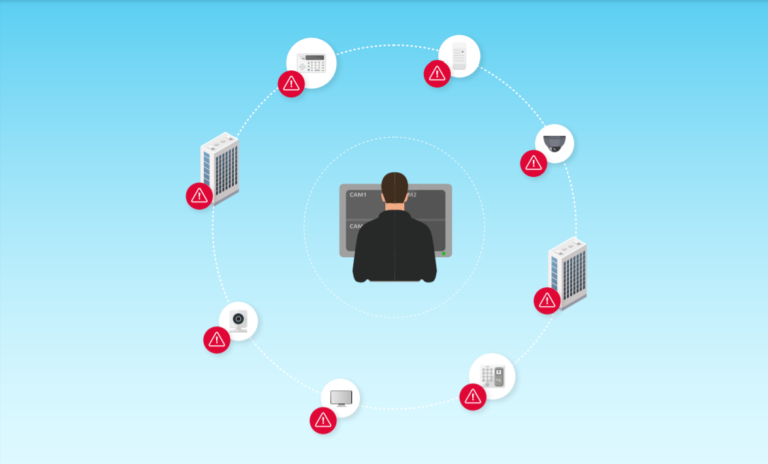
Organizations are becoming increasingly reliant on physical security devices to strengthen their essential business and security operations. From security cameras around the premises, to access control for their buildings, to intercoms and beyond, connected devices have become a critical part of enterprise infrastructure. With the volume and type of physical security devices continuously increasing, managing these devices at scale has become close to impossible to achieve manually.
An organization’s fleet of devices deployed in the field may run from hundreds to the tens of thousands and operationally managing them is a massive challenge. Physical security and IT teams within an organization will be posing questions, such as:
- Is every device working as expected?
- Are the devices compliant with the organization’s policies?
- Are the devices secure?
- Do they pose a risk to the organization?
- When an issue arises, can the root cause be determined quickly? and
- Who is responsible for solving these issues?
With the proliferation of devices, a centralized and automated solution to manage them is fast becoming an essential component to any organization with a physical presence. IoTOps is a practice that allows the teams responsible for the operational management of physical security devices to manage these devices in a consolidated, automated and secure manner.
5 Business Benefits You Can Expect from an IoTOps Solution
When a centralized and automated IoTOps solution is deployed, organizations can expect to benefit from these five specific outcomes:
1. Improved system availability: Physical security teams rely on their fleet of devices to be available and working as expected. With IoTOps, it becomes possible to centrally manage operational issues proactively and efficiently. Instead of taking a reactive approach when a device becomes unavailable – with all the chaos and costs involved – the ability to automatically gather real-time data on device status:
- reduces time to identify an issue
- improves initial diagnosis of the issue
- directs issues to the correct teams to resolve
- reduces resolution time.
Efficiency is improved when the problem is pinpointed quickly, the relevant team is alerted, and the issue is fixed before it becomes a problem. Automating operations helps minimize device downtime and ensures devices are performing optimally. For example, issues of a device’s connectivity being unstable or restarting unexpectedly, are identified and the specific team responsible is notified directly.
2. Dramatic cost savings: Physical security teams must expend much manual effort to ensure their multitude of devices from different manufacturers are working as expected. Each device requires a regular password rotation, and firmware upgrades when released by the manufacturers – it is difficult to stay on top of it all. Oftentimes, they take a reactive approach: only when a problem is reported do they dispatch a technician to investigate and try to resolve the issue. It may take days or even months before the issue is found, exposing the organization to significant risk.
By implementing an IoTOps solution, teams can proactively automate operations in bulk, reducing the manual effort currently involved. Issues are diagnosed and resolved from one centralized platform, ensuring a cost-efficient always-on operation. A centralized system provides real-time device statuses and features that allow the team to remediate almost all issues remotely. This reduces the manual labor involved with operational management of the devices, minimizes the need for on-site visits, and lowers expenses related to these tasks. For example, if a remote access gate is not opening, the issue is often resolved by resetting the device. Achieving this as a remote action saves the high costs of dispatching a truck with technical personnel to investigate why the device is not working properly.
3. Improved compliance: As part of their responsibilities, IT teams develop best practices and policies to support the business while securing the technical infrastructure from attack. However, the operational management of physical security devices is different than for regular IT devices, in terms of the type of devices, how they are deployed, their physical accessibility, and the dependent devices in the ecosystem.
A single pane of glass solution makes it simple for organizations to implement internal policies for compliance, as they already do for regular IT devices. The team can determine policies for password rotations, firmware upgrades, and more. They can verify a device’s configuration and compliance with the policies defined, generating alerts if a device becomes non-compliant. For example, an organization with thousands of devices cannot easily manage password rotations manually. Using automation and bulk operations, a company policy to rotate passwords every 30 days and with a strong set of characters can be executed automatically with ease.
4. Protection from cyber threats: Clear and proactive operational management prevents security vulnerabilities from compromising devices. However, even if physical security teams are aware of what needs to be done to mitigate the risks posed by these devices, manually managing them at scale is either not feasible or becomes so time-consuming that they would be unable to carry out their regular day-to-day activities.
By automating the operational management of devices, the risk of vulnerabilities is mitigated, providing a greater level of protection from cyber threats. The attack vector is reduced significantly when an organization-wide policy for upgrading firmware is implemented automatically.
5. Visibility for future planning: It is an advantage for all teams involved to have clear visibility to effectively prepare and prioritize deployment and purchasing activities for new and replacement devices. Without a complete inventory of physical security devices that includes end of life details it is difficult for an organization to know when their devices will no longer be supported by the manufacturer, let alone effectively plan for their replacement.
A centralized system with a single view of the entire fleet of physical security devices provides advance notice when a device nears its end of life. Knowledge of end of life dates, sometimes provided by the manufacturers several years in advance, enables organizations to proactively plan and budget for device replacement.
Benefits delivered by an IoTOps solution
As physical security devices take on an increasingly significant role in business operations, organizations must take a fresh look at their ability to efficiently manage these devices at scale. IoTOps has emerged as the multi-disciplinary solution – complementing physical security and IT disciplines – to ensure the risk detection, predictive maintenance, and automated operations of the organization’s fleet of devices.
SecuriThings Enterprise delivers these capabilities and benefits, empowering you to manage physical security devices at scale by streamlining the operational management of all your connected devices. Integrated into one single, convenient platform, SecuriThings Enterprise provides you detailed, actionable analytics, in real-time, across all sites and all connected devices. This way, you can face the ever-growing challenge of managing physical security devices with a new level of simplicity and efficiency. Download our brochure to learn more.




